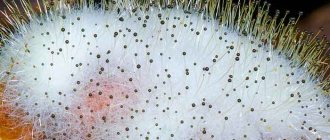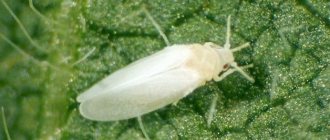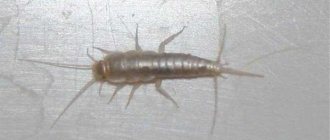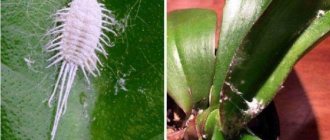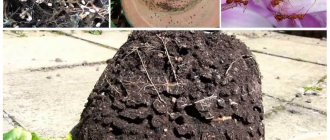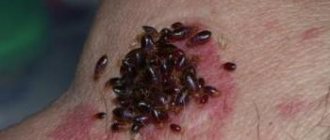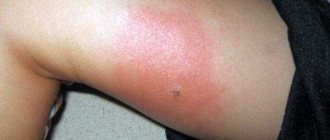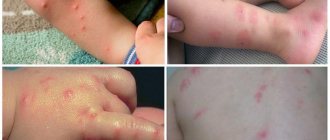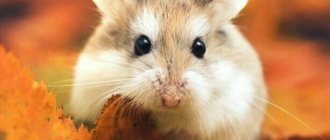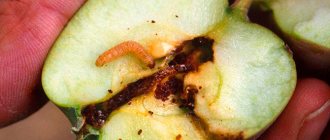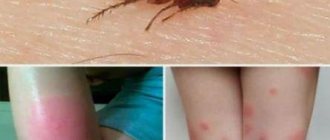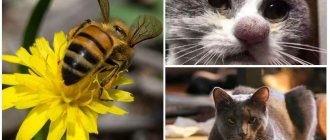What are earth fleas?
This type of flea got its name because of its habitat, but in appearance they are similar to their relatives that live on rats, dogs, cats and other animals.
What they look like
The body length of an adult flea reaches 2-3 mm. Males are smaller than females. The parasite is covered with a durable chitinous carapace of dark brown color. Its body is flattened laterally, which provides good streamlining when jumping.
The body of an insect, consisting of 3 sections, incl. head, chest and abdomen, characterized by an ovoid shape. The abdomen has the largest volume, because it fills with blood as the parasite feeds. The earth flea has 3 pairs of legs. They have serrations that help them cling to the fur and skin of the victim.
Only the hind legs - the longest ones - are used in jumping. The parasite covers a distance of 25-30 cm in one movement. It is believed that it is capable of jumping 75-100 cm in height. The flea, using its hind legs, shoots itself, so its jumps are chaotic.
Parasites have poor vision, but the sensory apparatus present on the back of the abdomen helps to detect even minor vibrations.
In addition, fleas are able to smell the blood and sweat of a victim at a distance of 2-3 m.
Adults have a piercing-sucking apparatus. When attacked, the parasite first pierces the skin and injects a special enzyme that prevents blood clotting and causes severe pain. After this, the flea expands the wound with blades and begins to feed, pumping blood into the expanding abdomen.
What do they eat?
Adults feed only on the tissue of warm-blooded animals. A flea can consume up to 1 ml of blood in one bite. For normal life, the parasite needs to feed at least once every 2-3 days. He makes many punctures on the skin of the legs until he finds a place where the vessels are located close to the surface.
How do they reproduce?
The breeding season for parasites lasts from mid-April to the end of September. During her life, a female can produce up to 500 eggs. Although adults are ready to mate immediately after emerging from the cocoon, the female must first find a warm-blooded animal and bite it. If the act of feeding has taken place, after about 48 hours the flea finds a secluded, cool place with a sufficient level of humidity and begins laying.
It can contain up to 40-50 eggs, covered with a special protective white shell. The eggs of parasites are oval in shape and their size does not exceed 0.1 mm. Under favorable conditions, larvae quickly emerge from them. In most cases it takes no more than 2-10 days.
Flea larvae resemble small worms covered with sparse hairs. They feed on decaying organic matter. After 7-21 days the larva pupates. A flea can spend from 7 to 200 days in the form of a pupa. If conditions are favorable, the insect quickly emerges from the cocoon, becoming an adult.
How long do they live?
Life cycle of a flea.
The lifespan of a flea depends on external conditions. Individuals overwintering in deep layers of soil often die during frosty and snowless winters. Under favorable conditions, they can live 1.5-2 years.
Midges in flowers: prevention of occurrence
To eliminate even the possibility of the appearance of midges, preventive measures should be taken:
- Avoid stagnation of water in the soil; be sure to arrange drainage in the pots. Drain water from trays after watering.
- Follow the watering regime: you can water the flowers only after the soil in the pot dries.
Excess moisture can cause another problem - the formation of a white coating on the soil.
- Carry out regular loosening of the soil. This helps saturate the soil with oxygen and improves air exchange in it. And this, in turn, prevents soil rotting.
- Dust the surface of the soil in the pot with ground cinnamon and the midges will avoid the pot.
To combat such a scourge as midges in flowers, it is worth taking immediate measures. And it’s better to do this as a whole. Let your indoor flowers be healthy and delight you with a healthy appearance.
Habitats
Ground fleas live in the soil . In winter, they bury themselves 15-20 cm into the ground and pupate. With the onset of warmth, they leave their cocoons and move to the upper layers of the soil. An increase in their numbers is observed when it rained for some time, and then the heat came. High air temperatures and high humidity are the most suitable conditions for these insects. Adult parasites begin to search for a victim.
Fleas don't only live in the ground. They can be found and reproduce in human homes. They live in rooms with high humidity. They attack apartments on the first floors. They are especially common in homes where people neglect sanitary standards.
Good hiding places for them:
- a pile of clothes;
- cracks in the floor;
- folds of upholstered furniture;
- long carpet pile, etc.
In addition, fleas choose outbuildings. They live in animal bedding and places where old things are stored.
Reasons for the appearance of midges in flower pots
The first and most important reason why midges appear in flower pots is excessive soil moisture. Because these are the most favorable conditions for their reproduction.
Other conditions may include:
- The use of low-quality soil that has not undergone appropriate treatment when growing flowers.
- If disproportionately large containers are used for growing plants. Because the root system of the plant is not able to absorb moisture from the entire soil coma. As a result, moisture stagnates in the lower part of the pot - ideal conditions for the life of midges.
- An excess of organic fertilizers in the soil is also a favorable environment for the proliferation of pests. Organics are a very attractive environment for them.
- Midges can fly into the house through a window or a ventilation grill from the shaft. And immediately they will find flower bowls with waterlogged soil.
The danger of insect bites for humans
Biting insects such as fleas are extremely dangerous because... are carriers of many infectious diseases that require long-term treatment.
Among them:
- plague;
- encephalitis;
- listeriosis;
- anthrax;
- typhus;
- tuberculosis;
- hepatitis;
- tularemia.
Flea bites.
Flea bites are a source of helminthic and fungal infestation. The parasite injects its saliva during feeding. The bite site is very itchy and may become red. People who are sensitive to the enzymes present in the saliva of these fleas may experience allergic reactions.
First aid
The feet, ankles and ankles are the most common sites where the legs are affected. Areas of insect attack may be invisible, but damage to the skin is indicated by itching. If there are no severe allergic reactions, bites can be treated at home.
The affected area must be treated with a disinfectant. A cold compress helps relieve itching. In addition, it is recommended to use an ointment that includes antihistamines. If signs of allergy or intoxication of the body appear, you cannot carry out treatment on your own; you should seek medical help.
If fleas have bitten a child
Focal redness appears on children's skin at the sites of bites. The child experiences severe discomfort due to itching. Bite areas must be treated with a disinfectant and a cold compress applied. If there are many areas of damage, you should consult a doctor, because... Antihistamines may be required to relieve symptoms.
How to get rid of fleas in a house with a child
Some commercial insect repellents can cause a severe allergic reaction in a child, so such products should only be used if the child is not present.
In other situations, it is better to use safer methods, for example:
- Buy repellents that contain natural substances, for example: wormwood, cedar oil and mint.
- Buy shampoo based on eucalyptus, juniper, lavender and geranium. Children love to hang out with pets, so pets need to be bathed regularly, thoroughly washing the neck and chin. After bathing, the animal must be treated again. To do this, you need to prepare a solution in advance: boil one lemon in half a liter of water, leave the solution for seven hours.
- It is necessary to regularly ventilate the room, carry out general cleaning, and heat treat children's clothes with an iron.
- It is important to wash outdoor shoes, paying special attention to the soles.
Such recommendations will protect your apartment from fleas.
Methods of disposal
If the number of fleas in a residential area is small, you can fight them with chemical insecticides. There are many effective means that can be used to poison these insects, but when using them, some precautions should be taken to avoid poisoning. If this option is undesirable, you can use folk remedies to kill fleas.
In apartments on the first floors, even with the use of folk and chemical remedies, fleas appear again after a short time. This indicates that the basement is infested with them. In this case, fighting with simple methods will not help and you should turn to professionals to thoroughly disinfect not only the apartment, but also the areas underneath it.
Professional pest control
Professional pest control is the most effective. Experts agree to poison insects even in large rooms. They use special equipment and potent insecticides that can destroy not only adults, but also eggs, larvae and pupae. Many companies provide a guarantee for their services and, if necessary, carry out repeated disinfestation free of charge.
Chemicals
The most common method of killing fleas is to treat the premises with chemical insecticides. They are available in the form of powders, concentrates, aerosols, drops, and emulsions.
Option for a remedy for earthen fleas.
Insect control can be carried out with the following drugs:
- "Clean house".
- “Butox 50”.
- "Raptor".
- “Ecokiller”.
- "Phenaxin".
- “Nats.”
- "Raid".
- "Combat".
- "Dichlorvos".
It is difficult to determine which product is the best. One treatment with any of these drugs does not always give a good result, because... they are unable to destroy flea eggs. To achieve a positive effect, it is advisable to carry out 2-3 procedures with an interval of 5 days.
Folk remedies
Folk remedies that help repel fleas are recommended to be used when the number of insects in the house is small. To poison parasites, you can prepare a mixture of soda and salt. The components are taken in equal proportions. The composition should be thoroughly treated with all carpets and sprinkled in corners and on the floor in the basement. Turpentine can be used to treat outbuildings.
Herbal products are also effective in controlling fleas. A decoction of wormwood and tansy helps to quickly eliminate parasites. To prepare it, 2 cups of wormwood are mixed with 1 cup of tansy and 1 cup of eucalyptus.
The composition must be filled with 10 liters of hot water. The mixture is boiled for 3-5 minutes. After this, the container with it is removed from the heat, wrapped in a blanket and left to infuse for a day. The finished product should be filtered, poured into a spray bottle and used to treat the room.
To repel fleas, it is recommended to place spruce and pine branches in the corners of the living room. These insects cannot tolerate the smell of pine needles. To treat the room, brewer's yeast and garlic are used, mixed in equal proportions. The mixture should be rubbed onto all places where fleas can enter the house.
Folk remedies for fleas.
Safety precautions when removing fleas
Since most insecticides are toxic and can harm the human body, you should not neglect the means of protection. You will need:
- respirator, gauze bandage,
- protective glasses,
- latex gloves.
Do not forget to ventilate the room after treatment for several hours. It would be ideal if you can leave the house for 1-2 days during the treatment.
If there are children or pregnant women in the house
Small children crawl around the apartment, touch everything with their hands, and then put their fingers in their mouths. Pregnant women inhale harmful fumes, which can negatively affect the development of the fetus. In such cases, you can use only completely safe products. These are the same folk remedies, with the exception of boric acid, botanical dust and kerosene (its smell can cause nausea in pregnant women) or based on neonicotinoids, neostomazan (look on the package). Children and pregnant women must leave the house during chemical treatment. After the procedure, a thorough wet cleaning is carried out and the room is ventilated for a long time.
If there are animals in the house
It is not advisable for pets and birds to be in the house during treatment. If there is nowhere to put them, then it is recommended to use only those products that are sold in a veterinary pharmacy and are safe for animals, for example, drugs with the active ingredients fipronil, neonicotinoids, neostomazan.
Preparing the premises
An important condition for achieving a good result is careful preparation of the room for processing. All unnecessary old things and garbage should be thrown away. It is advisable to vacuum the floor. It is recommended to knock out carpets. In addition, be sure to treat all surfaces with soapy water.
Furniture should be immediately coated with special agents that repel parasites. Products must be refrigerated during disinfection to prevent chemicals from coming into contact with them. After this, you should close all windows tightly and begin processing the room.
How to remove fleas from your home forever with minimal cost
To get rid of flea infestations, special insecticidal chemicals are used in the house:
- aerosols such as Dichlorvos, Combat, Raptor;
- special concentrated substances: Cypermethrin, Tetramethrin, Permethrin, etc. They need to be diluted with warm water, poured into a spray bottle, and sprayed throughout the apartment;
- powder products: Phenaxin, Clean House.
These tools must be used, since without them it is impossible to solve the problem. After them, you need to use traditional methods of ridding your apartment of parasites; they will play the role of preventive measures.
Good to know!
For example, you can take branches of wormwood or any spruce trees and scatter them in the corners of the rooms. Their pungent smell will repel fleas, and they will simply try to get out of the house.
